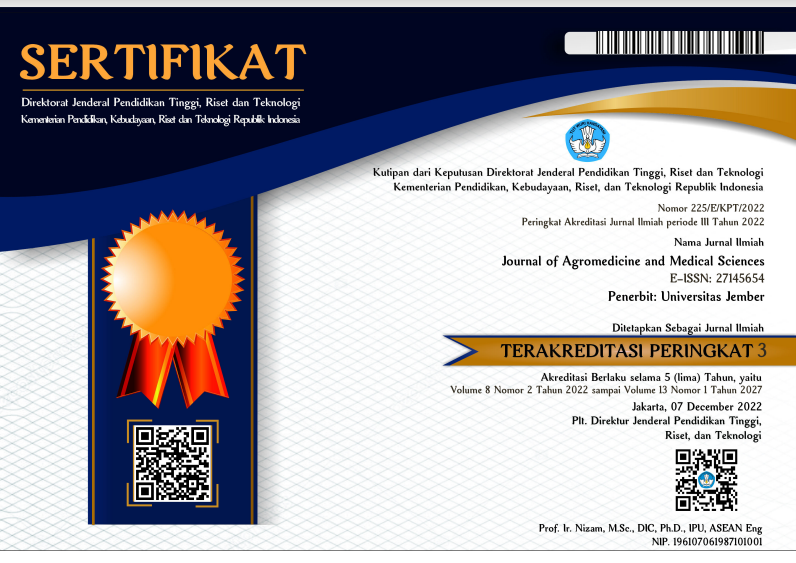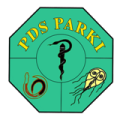A Case Report: The Effect of Thread Embedding Acupuncture on Partly-Controlled Asthma
DOI:
https://doi.org/10.19184/ams.v7i2.26635Abstract
Asthma is a chronic inflammatory disorder of the respiratory tract where many cells and cellular elements play a role, especially eosinophils, IgE, and other components. Uncontrolled asthma causes the quality of the patient's life to decline. Acupuncture is one of the complementary therapies that are scientifically proven to help cure asthma. Many studies have proven that acupuncture plays a role in the anti-inflammatory process. In this case report, we used the acupuncture method of thread embedding penetration from point EX-B1 to BL13, LI11, ST36, and BL23 on both sides. Acupuncture therapy is done once when the patient first arrives. The results after 3 months observations showed that patients experienced an improvement in eosinophil count, decreased level of IgE, and increased Asthma Control Test values. The improvement showed patients were fully controlled in the first month until the end of the evaluation. Therefore, thread embedding could be a good, safe, and effective treatment for asthma in adults.
Keywords: asthma, thread embedding acupuncture, anti-inflammation
Downloads
References
Burrows Benjamin, Martinez Fernando, Halonen, Barbee Robert, C. M. (1989). The New England Journal of Medicine Downloaded from nejm.org at UNIV OF UTAH ECCLES on June 27, 2014. For personal use only. No other uses without permission. From the NEJM Archive. Copyright © 2010 Massachusetts Medical Society. All rights reserved. New England Journal of Medicine, 271–277.
Cho, Y., Lee, S., Kim, J., Kang, J. W., & Lee, J. D. (2018). Thread embedding acupuncture for musculoskeletal pain: A systematic review and meta-analysis protocol. BMJ Open, 8(1), 1–5. https://doi.org/10.1136/bmjopen-2016-015461
Cui, W., Sun, W., Mao-Ying, Q.-L., Mi, W., Chu, Y., & Wang, Y. (2018). Evaluation of catgut implantation at acupoints for asthma: A systematic review and meta-analysis. Traditional Medicine and Modern Medicine, 01(02), 123–132. https://doi.org/10.1142/s2575900018400025
Enfumosa, T., & Group, S. (2003). The ENFUMOSA cross-sectional European multicentre study of the clinical phenotype of chronic severe asthma. 470–477. https://doi.org/ 10.1183/09031936.03.00261903
Fu, M., Huang, H., & Wu, H. (2005). Clinical Research On Accupoint Catgut Embedding Therapy For Bronchial Asthma. Hebei Medicine, 11(6), 505–507. https://doi.org/10.1186/1745-6215-14-12
Gollapudi, S. (2014). Safety and Efficacy of Polydioxanone Nano-Fibers as Anti-Inflammatory Agents. Journal of Nanomedicine & Biotherapeutic Discovery, 04(02), 2–7. https://doi.org/10.4172/2155-983x.1000127
Halwani, R., Al-Muhsen, S., Al-Jahdali, H., & Hamid, Q. (2011). Role of transforming growth factor-β in airway remodeling in asthma. American Journal of Respiratory Cell and Molecular Biology, 44(2), 127–133. https://doi.org/10.1165/rcmb.2010-0027TR
Indonesia, R., & Kementerian Kesehatan. (2018). Hasil Utama Riset Kesehata Dasar (RISKESDAS). Jurnal Kementerian Kesehatan, 44(8), 1–200. https://doi.org/10.1088/1751-8113/44/8/085201
Initiative, G. (2020). Global Initiative for Asthma: Global strategy for asthma management and prevention (Updated 2020). Revue Francaise d’Allergologie et d’Immunologie Clinique, 36(6), 685–704. https://doi.org/10.1016/ S0335-7457(96)80056-6
Janulaityte, I., Januskevicius, A., Kalinauskaite-Zukauske, V., Bajoriuniene, I., & Malakauskas, K. (2020). In vivo allergen-activated eosinophils promote collagen I and fibronectin gene expression in airway smooth muscle cells via TGF-β1 signaling pathway in Asthma. International Journal of Molecular Sciences, 21(5), 1–19. https://doi.org/10.3390/ijms21051837
Kementerian Kesehatan Republik Indonesia, P. D. dan I. (2019). Penderita Asma di Indonesia. In Kementerian Kesehatan (Vol. 53, Issue 9). https://doi.org/10.1017/ CBO9781107 415324.004
Kim, J., Zheng, Z., Kim, H., Nam, K. A., & Chung, K. Y. (2017). Investigation on the Cutaneous Change Induced by Face-Lifting Monodirectional Barbed Polydioxanone Thread. Dermatologic Surgery, 43(1), 74–80. https://doi.org/ 10.1097/DSS.0000000000000925
Langevin, H. M., Churchill, D. L., & Cipolla, M. J. (2001). Mechanical signaling through connective tissue: a mechanism for the therapeutic effect of acupuncture. The FASEB Journal, 15(12), 2275–2282. https://doi.org/ 10.1096/fj.01-0015hyp
Li, X., Liu, Y., Zhang, Q., Xiang, N., He, M., Zhong, J., Chen, Q., & Wang, X. (2016). Effect of catgut implantation at acupoints for the treatment of allergic rhinitis: A randomized, sham-controlled trial. BMC Complementary and Alternative Medicine, 16(1), 1–11. https://doi.org/ 10.1186/s12906-016-1400-x
Liang, C., & Lun, X. (2009). Clinical Research on Acupoint catgut embedding theraphy for bronchial asthma. Chengkuochenjiu, 36(2), 264–265. https://doi.org/ 10.1097/MD.0000000000018933
Liu, C. F., & Chien, L. W. (2015). Efficacy of acupuncture in children with asthma: a systematic review. Italian Journal of Pediatrics, 41(1). https://doi.org/ 10.1186/s13052-015-0155-1
Ma, Y., Huang, W., Liu, C., Li, Y., Xia, Y., Yang, X., Sun, W., Bai, H., Li, Q., & Peng, Z. (2016). Immunization against TGF-β1 reduces collagen deposition but increases sustained inflammation in a murine asthma model. Human Vaccines and Immunotherapeutics, 12(7), 1876–1885. https://doi.org/10.1080/21645515.2016.1145849
Matucci, A., Vultaggio, A., Maggi, E., & Kasujee, I. (2018). Is IgE or eosinophils the key player in allergic asthma pathogenesis? Are we asking the right question? Respiratory Research, 19(1), 1–10. https://doi.org/ 10.1186/s12931-018-0813-0
McDonald, J. L., Cripps, A. W., Smith, P. K., Smith, C. A., Xue, C. C., & Golianu, B. (2013). The anti-inflammatory effects of acupuncture and their relevance to allergic rhinitis: A narrative review and proposed model. Evidence-Based Complementary and Alternative Medicine, 2013. https://doi.org/10.1155/2013/591796
Novak, N., & Bieber, T. (2003). Current perspectives Allergic and nonallergic forms of atopic. 252–262. https://doi.org/ 10.1067/mai.2003.1595
Pearls, C. (2018). How Do You Treat Asthma in Your Practice? . Medical Acupuncture, 30(2), 100–112. https://doi.org/ 10.1089/acu.2018.29078.cpl
Price, D. B., Rigazio, A., Campbell, J. D., Bleecker, E. R., Corrigan, C. J., Thomas, M., Wenzel, S. E., Wilson, A. M., Small, M. B., Gopalan, G., Ashton, V. L., Burden, A., Hillyer, E. V., Kerkhof, M., & Pavord, I. D. (2015). Blood eosinophil count and prospective annual asthma disease burden: A UK cohort study. The Lancet Respiratory Medicine, 3(11), 849–858. https://doi.org/10.1016/S2213-2600 (15) 00367-7
Rostini, L. (2014). Pengaruh terapi kombinasi akupunktur tanam benang dan medikamentosa terhadap keterkontrolan dan faal paru pada pasien asma bronkial derajat persisten sedang yang terkontrol sebagian dan tidak terkontrol. Fakultas Kedokteran Universitas Indonesia Program Studi Spesialis-1 Akupunktur Medik.
Services, U. D. of H. and H. (2007). National Asthma Education and Prevention Program Expert Panel Report 3 : Guidelines for the Diagnosis and Management of Asthma Full Report 2007. Children, 1–415.
Suzuki, M., Namura, K., Egawa, M., & Yano, T. (2006). Effect of Acupuncture Treatment in Patients with Bronchial Asthma. Zen Nihon Shinkyu Gakkai Zasshi (Journal of the Japan Society of Acupuncture and Moxibustion), 56(4), 616–627. https://doi.org/10.3777/jjsam.56.616
Thorsteinsdottir, B., Volcheck, G. W., Madsen, B. E., Patel, A. M., Li, J. T. C., & Lim, K. G. (2008). The ABCs of asthma control. Mayo Clinic Proceedings, 83(7), 814–820. https://doi.org/ 10.4065/83.7.814
Wen, C. Y. Z., Liu, Y. F., Zhou, L., Zhang, H. X., & Tu, S. H. (2015). A Systematic and Narrative Review of Acupuncture Point Application Therapies in the Treatment of Allergic Rhinitis and Asthma during Dog Days. Evidence-Based Complementary and Alternative Medicine, 2015, 1–11. https://doi.org/10.1155/2015/846851






















